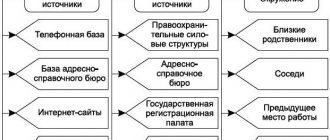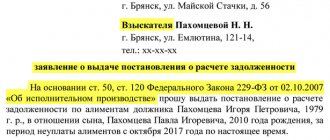Alimony obligations are personal, which does not provide for a change in the payer, but the claimant may well change. The conditions and grounds for this are specified in the legislation. Let's figure out in what case you can submit an application to replace the alimony claimant, how to properly file it and where to send it.
- Grounds for replacing the claimant
- How to fill out an application to replace the alimony claimant
- What is indicated in the application
- Applications
- Where to submit an application to replace the alimony claimant
- Acceptance and consideration of the application
Reasons for changing the claimant
In most cases, the parent living with the child receives child support. Trustees, adoptive parents, guardians and other persons established by law can also act as recipients.
Under some life circumstances, it is necessary to replace one claimant with another. Such circumstances may include:
- Death or recognition as deceased of the parent of the child with whom he or she permanently lived;
- Loss of rights of the parent who lived with the child;
- Replacing one child's guardian with another;
- Transferring the baby to a foster family.
In all these cases, the former claimant can no longer be the recipient of alimony, since the responsibilities for maintaining and raising the child have passed to another person.
The new guardian may be:
- A relative or other person appointed as a guardian;
- Adoptive parents;
- Guardianship;
- Children's social institution.
The right of children to collect alimony
Disabled children who receive child support payments for life can also request a change of recipient. If they have not been diagnosed with a mental illness due to which the incapacity was declared, children will be able to receive deductions instead of a guardian or trustee. The money will go directly to the account of the adult child.
Children who are in an educational institution fully funded by the state have a similar right.
Help for such children can be transferred to a personal account from parents deprived of parental rights.
Until they reach adulthood, the institution’s pupils cannot use the funds, but after leaving the organization and gaining legal capacity, children will be able to use the money in the account at their own discretion.
Deductions are made on the basis of a writ of execution in which the claimant is indicated. If it is necessary to make adjustments, a document is drawn up on the basis of which the recipient will be changed.
Procedure
If the payment of alimony is carried out on the basis of an agreement concluded between the parties, the change of recipient is made by drawing up a new agreement with a different recipient.
In this case, it is necessary to cancel the previously concluded agreement. To cancel, a notarized agreement on termination of the document on payment of alimony is drawn up.
If one of the parties does not agree to change the recipient, it is necessary to go to court.
In relation to minors who have lost a parent receiving alimony, the initiative to change the claimant may be taken by:
- guardian, trustee, foster parent;
- educational institution where the child lives.
When filling out a replacement for a claimant, they are guided by the provisions of regulatory legal acts:
- Art. 44 Code of Civil Procedure of the Russian Federation. The article formulates the principle of procedural succession: if one of the parties to legal relations based on an established court decision drops out, it is allowed to replace this party with its successor. The essence of the obligations remains unchanged.
- Art. 84 of the RF IC gives the right to apply for penalties in favor of children left without parental care. Money for the maintenance of a minor goes to the account of the organization in which the child is located. Amounts may be deposited in a bank. Income from alimony payments is divided into 2 parts: 50% goes to support the child, the other half goes to the minor’s bank account.
- Art. 203 of the Code of Civil Procedure of the Russian Federation indicates the possibility of changing a court decision, the method and procedure for its execution.
The procedure for replacing a claimant involves filing an application with the court on the part of a potential recipient or a bailiff. The latter, although they have the right to go to court, are often refused due to the lack of documents that are the basis for changing the recipient.
The official change of recipient of assistance is carried out in several stages:
- Notifying the bailiff of the need to replace the claimant. Based on the information received and available evidence, the bailiff can personally go to court. In case of refusal, the interested person has the right to independently write a statement and contact the judicial authority that issued the writ of execution.
- Preparation of a documentation package.
- Going to court. Based on the submitted materials, the judge makes a decision on the possibility of replacing the claimant. If the decision is positive, a writ of execution is issued.
- Submitting a writ of execution to the FSSP with an application to replace the claimant.
Preparing an application poses particular difficulties. But following the instructions, you can draw up the document yourself.
Changing the recipient when paying alimony under the agreement
Financial (material) support for a child can be provided by one of the parents voluntarily. For this purpose, a contract (agreement) on alimony may be concluded between him and the second parent or other person. In this document, the parties agree on the amount of payments, methods and procedures for their implementation, as well as other conditions that do not contradict the law. In order for the agreement to have legal force, it must be notarized.
When the obligations for maintenance and upbringing are transferred to another citizen, the alimony payer has the right to renew the agreement with him, and also continue to pay alimony on a voluntary basis. In this case, you will not have to go through any legal procedures to change the recipient.
If the payer paid the money on a contractual basis, but refused to enter into such a document with the new guardian, then the new guardian will have to file a claim for alimony.
Legal consequences of filing an application
Having considered the application, the bailiff may make a decision on:
- resumption of collection;
- partial renewal of deductions from the parent’s income;
- refusal to satisfy the claimant's demands.
Any of the documents can be appealed by both the recipient of funds and the debtor, since bailiffs often commit violations. After receiving a refusal from them, it is recommended to contact a higher division of the FSSP. The document will be reviewed within 10 days from the date of receipt. If the results of the consideration of the complaint do not satisfy the claimant, then there is no need to refuse further actions. The claimant has the right to file an administrative claim with the district court.
How to replace the recipient due to reaching the age of majority
This procedure is formal in nature. In order to make a replacement, it is enough to contact the bailiff with your passport and application. The bailiff himself initiates the replacement process, after which the adult citizen will be able to begin receiving his money.
The application to the BSC can be drawn up in any form, however, it must contain:
- The name of the territorial branch of the SSP in which the enforcement proceedings were opened;
- FULL NAME. bailiff;
- Information about the court decision, order or writ of execution on the basis of which alimony was paid (number, by whom and when it was issued);
- Information about enforcement proceedings (number, date);
- Request to replace the claimant due to the recipient reaching the age of majority.
The application can be signed and submitted by both the new and old claimant, or their representative, endowed with a notarized power of attorney.
Contents of the statement
The law does not call the document in question a statement of claim. It really is not a claim. Meanwhile, the process of its consideration occurs with the participation of the parties to the case. In addition, the structure of the document is quite similar to a lawsuit.
How to write a statement so that the collected amount of funds begins to flow to the new legal representative? Particular attention should be paid to the content of the document. It should reflect the following information:
- about the court where the claim is made;
- about the applicant and interested parties;
- about the initial judicial act on the basis of which money is recovered from the minor;
- about the documents on the basis of which the composition of legal representatives was changed;
- about the applicant's demands regarding the replacement of the claimant.
You must immediately indicate the bank details of the account to which the money will need to be transferred if the requirements contained in the application are met.
The court, having considered the issue, makes a decision on it, which is formalized in the form of a ruling. The law allows for the possibility of filing a private complaint against this act. However, as a rule, there are no grounds for appeal. Next, a writ of execution is drawn up, which is transferred to the FSSP department or another person responsible for dealing with the issue of execution of judicial acts on alimony.
Thus, there is nothing complicated in the procedure for replacing the alimony claimant. Main:
- fill out the application correctly;
- clearly formulate the requirements;
- attach all necessary documents.
Having spent a relatively small amount of time, the new legal representative of the child will be able to independently receive alimony funds.
Replacement procedure for guardians
When a guardian is appointed for a child, the claimant is replaced in court. Both the guardian himself and the bailiff can initiate consideration of the case in court. Also, the applicants can be the alimony payer and the previous alimony recipient, if he is alive.
In order for the court to issue a ruling on replacement, the applicant will need:
- Collect a package of documents confirming the right to receive alimony (death certificate of the child’s parent, document on loss of parental rights, court decision to appoint a guardian, etc.), as well as other documents confirming the information specified in the claim;
- Prepare an application;
- Submit documents to the judicial authority that made the decision or order on alimony. Documents can be transferred in person or through a representative by proxy to the court office. It is also possible to send documents by post (by registered mail, with notification).
After receiving documents from the applicant, the court appoints the case for consideration and invites the parties to participate in the process.
Based on the results of the consideration of the case, the court makes a decision to replace the recipient, or refuses to satisfy the applicant’s demands.
Grounds for replacing the claimant
- deprivation of parental rights, death of a parent - the right of collection passes to the guardian or social institution in which the child will live;
- reorganization (including liquidation) of a social institution – the right of collection is transferred to the new social institution;
- death, replacement of a guardian - the right of collection passes to the new guardians, social institution;
- transfer of a child from a social institution to guardians (without adoption) – the right of collection passes to the guardians.
Important! The adoption of a child to another family is not a basis for replacing the claimant, since in this case the alimony obligations are terminated in accordance with Part 2 of Article 120 of the RF IC.
A slightly different approach is practiced in the presence of alimony arrears. The right to collect debt may transfer:
- to new caregivers;
- social institution;
- the child himself (if he has reached the age of 18);
- to the child's heirs (in the event of his death).
In case of alimony arrears, it is also possible to replace the debtor, but only if he has died and he has heirs who have accepted the inheritance.
We will definitely consider such rare options as the withdrawal of the claimant or the debtor in the presence of alimony debt in another article. Here we will figure out how to correctly transfer the foreclosure to a new claimant.
How to draw up an application for guardians, a sample application to the court
An application to the court must be made in writing. The Code of Civil Procedure of the Russian Federation does not contain mandatory requirements for documents of this kind. This means that they can be compiled in any form. In this case, the applicant must be guided by the general principles of drawing up legal documents.
The application for a replacement recipient must include the following information:
- Name of the court;
- Information about the parties and third parties to the process;
- Circumstances that resulted in the need to replace the claimant;
- Information about enforcement proceedings (case number, date, amount of alimony paid, method of payment, full name of the child to whom the money is paid);
- Information about documents and other evidence confirming the circumstances specified in the application;
- A request to the court to replace the claimant, as well as to issue a new writ of execution;
- List of attached documents;
- Date of application;
- Applicant's signature with transcript.
The total period for the court to issue a ruling is 30 days. The new writ of execution is handed over to the bailiff, who is obliged to issue a replacement order within 3 days.
applications for replacement of the claimant
Arbitrage practice
As judicial practice shows, the process of replacing a claimant is a simple and formal procedure that does not cause difficulties. Of course, if the stated requirement is legal and justified.
When considering a case, the court takes into account all documents and other evidence submitted to it. If the request is justified, the court will grant it. If it is impossible to replace the claimant, the court will refuse to satisfy the application, making sure to set out the reasons for the refusal in the decision.
As a rule, the court refuses to replace the claimant due to the incomplete procedure for registering guardianship/trusteeship and the lack of relevant documents. But exceptions are allowed. If the circumstances and the totality of evidence speaks in favor of the applicant interested in receiving money for the maintenance of the child.
The court's refusal can be appealed to a higher judicial authority.
Example The grandmother of a minor child, O. Lezhneva, applied to the Bailiff Service with a request to appoint her as alimony collector, indicating that her own daughter, the child’s mother, had died. After the death of the child's mother, child support payments from the father stopped.
The bailiff refused to replace the claimant because custody of the child had not yet been formalized. Lezhneva O. went to court. The court took into account all the circumstances of the case: the child’s cohabitation with his grandmother, the process of registering guardianship of the child, the need for funds to support the child due to the financial situation of his guardian. The application was granted, the writ of execution was transferred to the Bailiff Service for forced collection of payments.
Difficulties may also arise in connection with the alimony payer. For example, if he starts hiding, refuses to provide funds, or hides income.
Expert opinion
Semyon Frolov
Lawyer. 7 years of experience. Specialization: family, inheritance, housing law.
If you don’t know where to start, or need legal support in the process of collecting alimony, write to us.
Our lawyer will advise you, answer all questions and advise you on how to proceed - at any stage of the procedure. Remember! Without compelling reasons and a sufficient evidence base, it is hardly possible to make changes to the enforcement process. Enlist the support of a lawyer and act exclusively in the right field. Attention!
- Due to frequent changes in legislation, information sometimes becomes outdated faster than we can update it on the website.
- All cases are very individual and depend on many factors. Basic information does not guarantee a solution to your specific problems.
That's why FREE expert consultants work for you around the clock!
- via the form (below), or via online chat
- Call the hotline:
- Moscow and the Region
- St. Petersburg and region
- FREE for a lawyer!
By submitting data you agree to the Consent to PD Processing, PD Processing Policy and User Agreement.
Anonymously
Information about you will not be disclosed
Fast
Fill out the form and a lawyer will contact you within 5 minutes
Tell your friends
Rate ( 3 ratings, average: 5.00 out of 5)
Author of the article
Irina Garmash
Family law consultant.
Author's rating
Articles written
612
When can a writ of execution be filed?
A writ of execution for the collection of alimony: how to obtain, payment deadline and presentation. Keep all checks and receipts issued, they will help track the location of the money and prove its receipt by the collector. Please note that there is a fee for wire transfers, but payments are well controlled. The secretary of the judge considering the case of the alimony obligee is responsible for filling out the form, and he also issues it to authorized people.
Alimony funds are withheld from all official income, namely:
Contacting the FSSP
If the result is positive, the applicant must contact the FSSP and notify about the change in the recipient of alimony. The information is presented in a statement drawn up according to the following model:
In rare cases, the bailiff may refuse to change the claimant due to employment, hostility and other reasons. Then it is necessary to immediately file a complaint with the senior bailiff, describe the situation, and if the latter fails to act, contact the prosecutor’s office.
In order not to be refused, you need to prepare for the process: collect evidence, indicate the legal acts according to which the application is being processed.
FREE CONSULTATIONS are available for you! If you want to solve exactly your problem, then
:
- describe your situation to a lawyer in an online chat;
- write a question in the form below;
The alimony claimant must be replaced in cases where the obligations to raise a child receiving alimony are transferred from one person (for example, the parent with whom the child previously lived) to another. Such a transition may be due to various life circumstances, both dependent on the will of the child’s parents and not.
By law, children cannot act as recipients of child support for themselves until they reach 18 years of age. Until this age, the transfer or transfer of funds to the child is carried out to his legal representative, who is obliged to spend it exclusively on the maintenance of the minor child.
When is it necessary to replace the claimant?
A typical situation when it is necessary to apply to the court to change the claimant is as follows: for example, there is a child whose biological parents are deprived of the right to raise a minor. The guardianship authorities have taken the necessary measures to collect alimony, for example, from the “former” mother.
The child himself was transferred to a special state institution for upbringing, which receives and accumulates funds issued by the child support provider. But then the baby is adopted by a certain family.
Adoption takes place within the framework of the law, no disputes or pitfalls arise. But it is necessary to make adjustments to the enforcement procedure so that funds for the minor are transferred in favor of the new parents.
The bailiff conducting the case does not have the opportunity to independently make changes to the procedure for executing the initial judicial act on alimony.
The matter is too serious to be resolved without judicial review.
Conditions for payment of alimony after 18 years
Is it possible to collect child support for an adult child?
- salary, shares of revenue;
- additional payments for overtime work;
- maintenance of military personnel;
- bonuses;
- pension payments;
- scholarships;
- benefits for temporary disability, unemployment;
- income from individual entrepreneurship;
- income from rental of personal real estate;
- earnings of persons serving prison sentences.
Also, child support is not due to children who are under 18 years of age, but have already acquired full legal capacity:
If the caring parent intends to arrange payments for himself, then he must provide a certificate of disability of the child of group 1 since childhood.
Child support obligations after adulthood Lately, bailiffs are increasingly faced with the question of what to do with enforcement proceedings where the child is already 18 years old , but there is also arrears in child support payments. Practices vary by region: some make decisions to end enforcement proceedings due to the impossibility of collection, and most simply “keep” execution until any circumstances arise, for example, the collector gets tired and she takes the sheet herself, or, God forbid, the debtor will die, or something else will happen. In my opinion, the most logical thing to do is to go to court to terminate such enforcement proceedings. By virtue of Art. 407 of the Civil Code, any obligation can be terminated. Why is this not an obligation?
Can it be replaced?
Divorce is a common occurrence.
People who previously loved each other realize that they are completely different, and they are not comfortable together. Sometimes families fall apart due to the betrayal of one of the spouses. In this case, the relationship cannot be saved. Often, after a breakup, former lovers are left with a child to take care of. He remains to live with his mother, and his father is forced to financially support his child. The claimant is usually the mother.
There are situations when it is necessary to replace the claimant. The number of such cases is limited. They are:
- premature death of the party with whom the baby lived permanently;
- moving to father or mother. Here we mean the party who previously acted as the payer of alimony;
- change of guardian or trustee. We are talking about grandparents, aunts, uncles and other relatives;
- reorganization of the educational institution where the child was located;
- foster care by foster parents;
- registration of guardianship and relocation of a minor child to permanent residence with adoptive parents.
The procedure for acceptance and consideration by the court
A written appeal, drawn up in accordance with all requirements, must be accepted.
In case of refusal, the actions of the authorized person can be appealed. To do this, you can file a complaint with the senior bailiff or in court.
After accepting the application, the judge informs all interested parties about it. Regardless of the real need, the judge calls the parties to court to clarify certain issues.
However, this happens extremely rarely - usually the parties either do not appear at the meeting or are simply formally present there.
Since when issuing a corresponding judicial act, the judge is based on the evidence provided. If the reason for the appeal is justified, then the court satisfies the applicant’s demands and issues a ruling.
The court's refusal to satisfy the requirements may be appealed, but if the basis for changing the parties is unfounded, the appeal will not be satisfied.
The court must consider the case and make an appropriate decision within 30 days after the citizen’s appeal. After the judicial act comes into force, it is sent to the bailiffs.
They must inform all interested parties about the change of claimant and what rights have been transferred to the successor.
Changing sides in enforcement proceedings is not difficult; the main thing is to know where to go and how to fill out an application. In order for the applicant’s demands to be satisfied, he must provide the court or bailiff with undeniable evidence, since replacement is allowed only in exceptional cases.
If you have problems with the evidence base or you cannot draw up a statement, entrust this to experienced family lawyers.
- Due to constant changes in legislation, regulations and judicial practice, sometimes we do not have time to update the information on the site
- In 90% of cases, your legal problem is individual, so independent protection of rights and basic options for resolving the situation may often not be suitable and will only lead to a more complicated process!
Therefore, contact our lawyer for a FREE consultation right now and get rid of problems in the future!
In the field of alimony legal relations, replacing the alimony claimant is relevant in cases where funds are withheld for a child who is supported by the state or municipality and he has a guardian or trustee.
In such a matter one cannot do without a court. Even though it is obvious that the requirements of the guardian will be satisfied, the procedure established by law must be followed.
This article will discuss how the new legal representative of the child should act.







